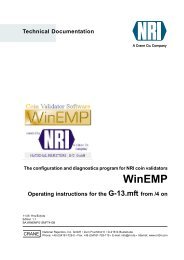3 Other operating modes of the G-18.mft - NRI
3 Other operating modes of the G-18.mft - NRI
3 Other operating modes of the G-18.mft - NRI
Create successful ePaper yourself
Turn your PDF publications into a flip-book with our unique Google optimized e-Paper software.
FUNCTIONS G-<strong>18.mft</strong> with vending machine control system<br />
Coin channels and memory blocks<br />
For <strong>the</strong> purpose <strong>of</strong> coin acceptance, <strong>the</strong> coin validator possesses 12 "memory<br />
slots" that can be assigned different coin types or tokens. These "memory<br />
slots" are termed coin channels. All <strong>the</strong> coin information that describes <strong>the</strong><br />
processing <strong>of</strong> an inserted coin is assigned to <strong>the</strong> coin channels; e.g. <strong>the</strong><br />
acceptance band <strong>of</strong> a coin type/token so that <strong>the</strong> coin type/token is accepted<br />
in that channel.<br />
To be able to reject false coins reliably, channels with a narrow or even a very<br />
narrow acceptance band are frequently set up for a coin type, in addition to<br />
<strong>the</strong> standard coin channel. The limit values <strong>of</strong> <strong>the</strong>se coin channels are closer<br />
to one ano<strong>the</strong>r so that false coins with similar measured values are rejected.<br />
Narrow and very narrow coin channels, however, also possess a lower<br />
acceptance rate.<br />
In addition, it is possible to allocate coins with different measured values but<br />
identical coin values to different coin channels. This is how <strong>the</strong> coin validator<br />
can, for example, accept old and new coins <strong>of</strong> <strong>the</strong> same type.<br />
However, a coin channel is not only assigned <strong>the</strong> acceptance band <strong>of</strong> a coin<br />
type but also o<strong>the</strong>r coin information which defines fur<strong>the</strong>r processing: e.g.<br />
coin values and inhibiting information.<br />
The memory <strong>of</strong> <strong>the</strong> coin validator can data-manage two separately<br />
programmed (memory) blocks 0 and 1 (see section "Label" in Chap. 4<br />
"Design"). The 12 coin channels can be assigned independently <strong>of</strong> one<br />
ano<strong>the</strong>r to each block with different coin types (also currencies), inhibiting<br />
information, etc. Only one block can be active at a time and be used for <strong>the</strong><br />
coin measurement and for fur<strong>the</strong>r coin processing. You can use <strong>the</strong><br />
switching blocks on <strong>the</strong> rear <strong>of</strong> <strong>the</strong> device to select <strong>the</strong> desired block (see<br />
section "Selecting memory block" in Chap. 7 "Operation").<br />
Since <strong>the</strong> customer-specific programming made by <strong>the</strong> manufacturer does<br />
not allocate all 12 coin channels <strong>of</strong> memory block 0 and 1 in most cases,<br />
coin types and <strong>the</strong> desired fur<strong>the</strong>r information can be assigned to channels<br />
that are still free at any time using <strong>the</strong> configuration s<strong>of</strong>tware (see Chap. 9<br />
"Which functions can be set using WinEMP/PalmEMP?").<br />
The coin channels 7 to 12 <strong>of</strong> <strong>the</strong> two memory blocks are intended for <strong>the</strong><br />
teach mode. New coin types/tokens can be taught in teach mode directly at<br />
<strong>the</strong> vending machine without using any fur<strong>the</strong>r tools (see section "Teaching<br />
coin channels in teach mode" in Chap. 7 "Operation").<br />
24 National Rejectors, Inc. GmbH, Buxtehude

















